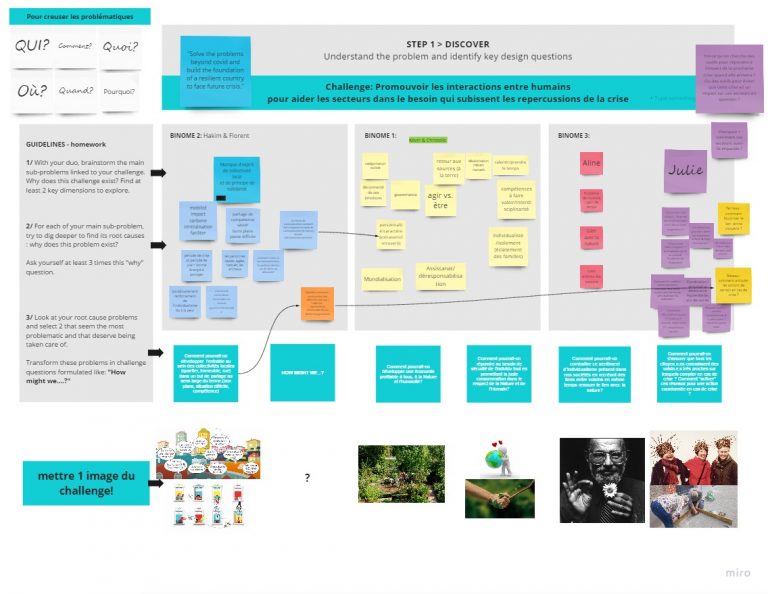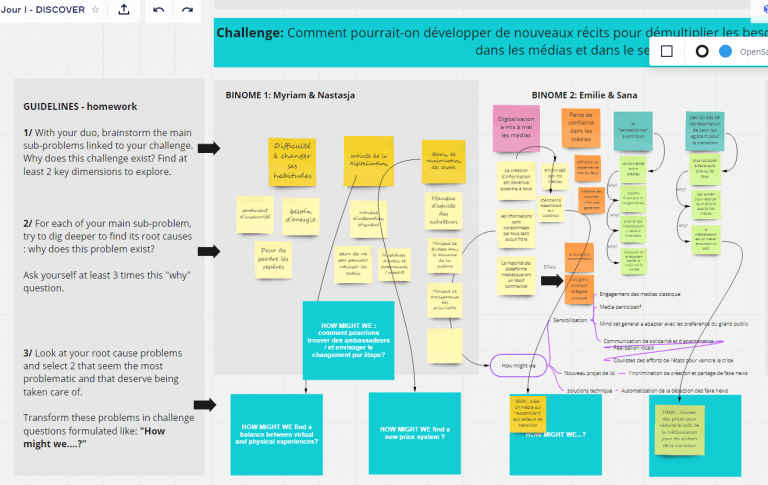Insights
Digital Inclusivity
We use online tools to keep in touch with our clients and beneficiaries. Recently, we got confronted on our choices: the tools we use are not inclusive.
Regarding digital tools, inclusivity can, for example, look like being careful and putting efforts and attention into the digital gap, and choosing understandable and usable tools by blind people.
We use Miro as our collaborative online tool in our workshops, hackathons and training. It’s amazing. But Miro excludes blind and partially sighted people. They usually use software that reads the content of a web page for them. This software is useless on Miro.
What were we supposed to do? Say no to blind or partially sighted participants? Or adapt and learn to become a better facilitation agency? We decided to take the second option.
We use Miro as our collaborative online tool in our workshops, hackathons and training. It’s amazing. But Miro excludes blind and partially sighted people. They usually use software that reads the content of a web page for them. This software is useless on Miro.
What were we supposed to do? Say no to blind or partially sighted participants? Or adapt and learn to become a better facilitation agency? We decided to take the second option.


From valid people to valid people, there are some tips we wanted to share from our experience to allow more online events to be inclusive:
1. Bring a facilitator to manage the conversation. A facilitator is the guardian of the methodology, presentation, and handling of the tools and facilitating exchanges. They will make sure that everyone talks and describes what they have in their mind and written into their sticky notes. It will help the group integrate a blind or partially sighted person and move forward: explaining your reason, not taking anything for granted is an excellent way to improve brainstorming sessions.
2. The facilitator will take notes for the persons unable to do it, allowing everyone to contribute on the same level.
3. Export the content of your Miro board in a .csv Excel document. For that, don’t forget to put frames around what you want to export and give titles to them to organise your exports! Reading software can read a .csv document. This tip will allow everyone to keep in mind the progress and keep the final document.
We are in constant learning dynamic, and you, how do you make your online event more inclusive?
1. Bring a facilitator to manage the conversation. A facilitator is the guardian of the methodology, presentation, and handling of the tools and facilitating exchanges. They will make sure that everyone talks and describes what they have in their mind and written into their sticky notes. It will help the group integrate a blind or partially sighted person and move forward: explaining your reason, not taking anything for granted is an excellent way to improve brainstorming sessions.
2. The facilitator will take notes for the persons unable to do it, allowing everyone to contribute on the same level.
3. Export the content of your Miro board in a .csv Excel document. For that, don’t forget to put frames around what you want to export and give titles to them to organise your exports! Reading software can read a .csv document. This tip will allow everyone to keep in mind the progress and keep the final document.
We are in constant learning dynamic, and you, how do you make your online event more inclusive?
Contact Us
We Can Help
We would be pleased to exchange with you on your Sustainability Challenges. Where are you at? Where do you want to be? What could be your next steps? Let’s have a chat!
Email: hello@impact-valley.com
Phone: +32 478 45 23 63
